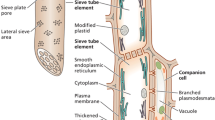Abstract
We propose a simplified alternative method for quantifying the partitioning of excitation energy between photochemistry, fluorescence and thermal dissipation. This alternative technique uses existing well-defined quantum efficiencies such as ΦPS II, leaving no 'excess' efficiency unaccounted for, effectively separates regulated and constitutive thermal dissipation processes, does not require the use of Fo and F′o measurements and gives very similar results to the method proposed by Kramer et al. [(2004) Photosynth Res 79: 209–218]. We demonstrate the use of the technique using chlorophyll fluorescence measurements in grapevine leaves and observe a high dependence on thermal dissipation processes (up to 75%) at both high light and low temperature.
Similar content being viewed by others
References
Anderson JM, Park YI and Chow WS (1997). Photoinactivation and photoprotection of Photosystem II in nature. Physiol Plant 100: 214–223
Bernacchi CJ, Portis AR, Nakano H, von Caemmerer S and Long SP (2002) Temperature response of mesophyll conductance. Implications for the determination of rubisco enzyme kinetics and for limitations to photosynthesis in vivo. Plant Physiol 130: 1992–1998
Bilger W, Schreiber U and Bock M (1995). Determination of the quantum effciency of PS II and of non-photochemical quenching of chlorophyll fluorescence in the field. Oecologia 102: 425–432
Björkman O and Demmig B (1987) Photon yield of O2 evolution and chlorophyll fluorescence characteristics at 77 K among vascular plants of diverse origin. Planta 170: 489–504
Cailly AL, Rizza F, Genty B and Harbinson J (1996) Fate of excitation at PS II in leaves. The non-photochemical side. Plant Physiol Biochemistry (special issue): 86
Chow WS (2003) Photosynthesis: from natural towards artificial. J Biol Phys 29: 447–459
Demmig-Adams B, Adams WW, Barker DH, Logan BA, Bowling BA and Verhoeven AS (1996) Using chlorophyll fluorescence to assess the fraction of absorbed light allocated to thermal dissipation of excess excitation. Physiol Plant 98: 253–264
Flexas J and Medrano H (2002) Energy dissipation in C3 plants under drought. Funct Plant Biol 29: 1209–1215
Genty B, Briantais J-M and Baker NR (1989) The relationship between quantum yield of photosynthetic electron transport and quenching of chlorophyllfluorescence. Biochim Biophys Acta 990: 87–92
Hendrickson L, Ball MC, Osmond CB, Furbank RT and Chow WS (2003) Assessment of photoprotection mechanisms of grapevine at low temperature. Funct Plant Biol 30: 631–642
Horton P and Hague A (1988) Studies on the induction of chlorophyllfluorescence in isolated barley protoplasts. IV. Resolution of non-photochemical quenching. Biochim Biophys Acta 932: 107–115
Hovenden MJ and Warren CR (1998) Photochemistry, energy dissipation and cold-hardening in Eucalyptus nitens and E. pauciflora. Aust J Plant Physiol 25: 581–589
Kato MC, Hikosaka K, Hirotsu N, Makino A and Hirose T (2003) The excess light energy that is neither utilized in photosynthesis nor dissipated by photoprotective mechanisms determines the rate of photoinactivation in Photosystem II. Plant Cell Physiol 44: 318–325
Kramer DM, Johnson G, Kiirats O and Edwards GE (2004) New fluorescence parameters for the determination of QA redox state and excitation energy fluxes. Photosynth Res 79: 209–218.
Lavergne J and Trissl HW (1995) Theory offluorescence induction in Photosystem II: Derivation of analytical expressions in a model including exciton-radical-pair equilibrium and restricted energy transfer between photosynthetic units. Biophys J 68: 2474–2492
Lee H-Y, Hong Y-N and Chow WS (2001) Photoinactivation of Photosystem II complexes and photoprotection by non-functional neighbours in Capsicum annuum L. leaves. Planta 212: 332–342
Melis M, Spangfort M and Andersson B (1987) Light-absorption and electron transport balance between Photosystem II and Photosystem I in spinach chloroplasts. Photochem Photobiol 45: 129–136
Müller P, Li X-P and Niyogi KK (2001) Non-photochemical quenching. A response to excess light energy. Plant Physiol 125: 1558–1566
Osmond CB (1989) Photosynthesis from the molecule to the biosphere: a challenge for integration. In: Briggs WR (ed) Photosynthesis, pp 5–17. Alan R. Liss, New York
Schatz GH, Brock H and Holzwarth AR (1988) Kinetic and energetic model for the primary processes in Photosystem II. Biophys J 54: 397–405
Schreiber U, Bilger W and Neubauer C (1994) Chlorophyll fluorescence as a non-intrusive indicator for rapid assessment of in vivo photosynthesis. In: Schulze E-D and Caldwell MM (eds) Ecophysiology of Photosynthesis, pp 49–70. Springer-Verlag, Berlin
Schultz HR (1996) Leaf absorptance of visible radiation in Vitis vinifera L: estimates of age and shade effects with a simple eld method. Sci Hort 66: 93–102
Trissl H-W and Lavergne J (1995) Fluorescence induction from Photosystem II: Analytical equations for the yields of photochemistry andfluorescence derived from analysis of a model including exciton radical pair equilibrium and restricted energy transfer between photosynthetic units. Aust J Plant Physiol 22: 183–193
Tsonev TD and Hikosaka K (2003) Contribution of electron transport, heat dissipation and recovery of photoinactivated Photosystem II to photoprotection at different temperatures. Plant Cell Physiol 44: 828–835
van Gorkom HJ (1985) Electron transfer in Photosystem II. Photosynth Res 6: 97–112
von Caemmerer S and Farquhar GD (1981) Some relationships between the biochemistry of photosynthesis and the gas exchange of leaves. Planta 153: 376–387
Author information
Authors and Affiliations
Rights and permissions
About this article
Cite this article
Hendrickson, L., Furbank, R.T. & Chow, W.S. A Simple Alternative Approach to Assessing the Fate of Absorbed Light Energy Using Chlorophyll Fluorescence. Photosynthesis Research 82, 73–81 (2004). https://doi.org/10.1023/B:PRES.0000040446.87305.f4
Issue Date:
DOI: https://doi.org/10.1023/B:PRES.0000040446.87305.f4




